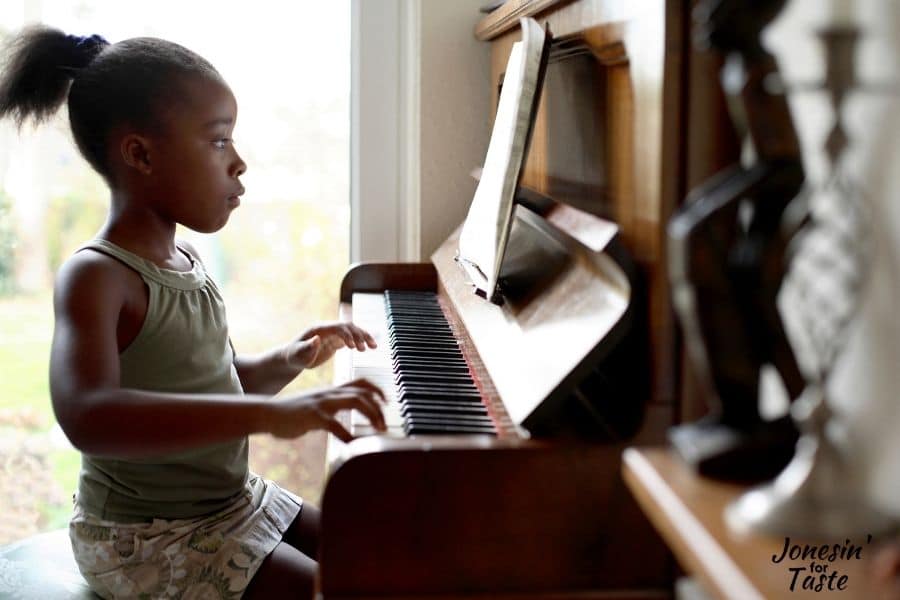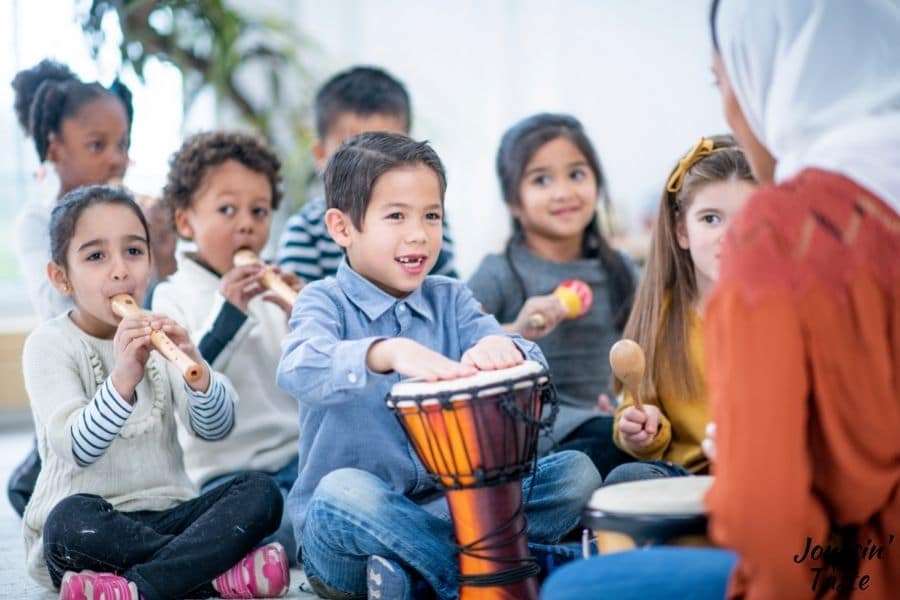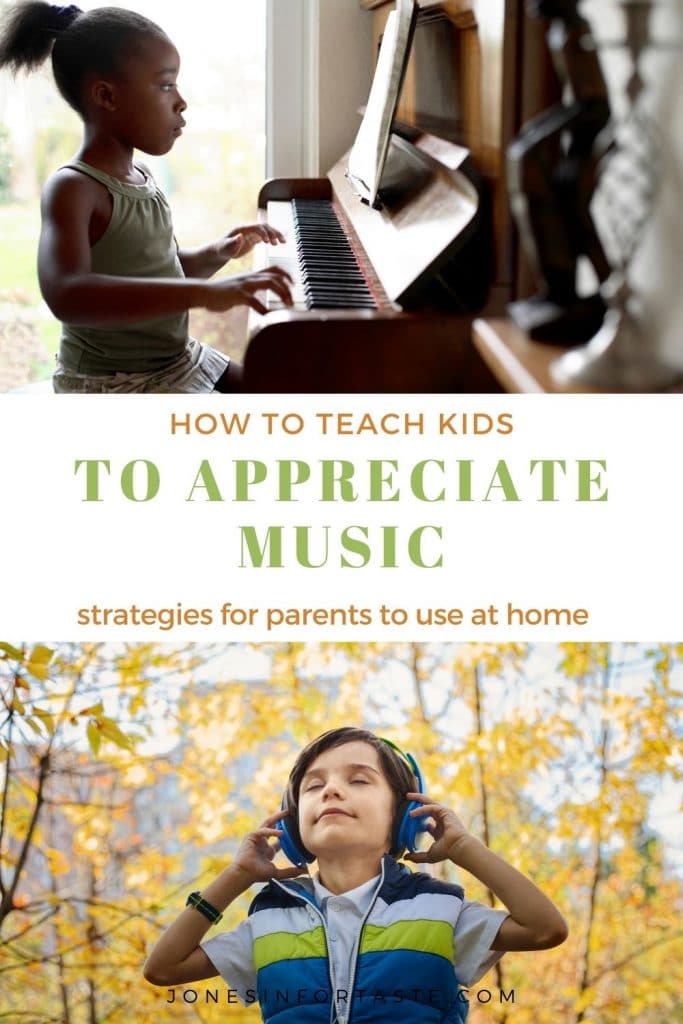10 Strategies To Teach Musical Appreciation At Home
Learn how music can benefit your children and help you to explore the world! Even if you don’t know how to teach musical appreciation at home to your children you can get started with these 10 easy strategies– no musical experience required!
Table of contents
Music education is an essential part of children’s development. However, many schools that have experienced budget cuts tend to cut art classes first – which is unfortunate for students since music is a powerful tool in education. Music is also a great way to bond and bring together people of all ages.
Having an appreciation for music and the advantages it gives are wonderful tools for children and adults alike. Bringing music into the home can benefit everyone. It does not matter if you have a musical talent or knack to play or sing. Music is a constant that brings multiple benefits.
Infants learn language through music when they are sang to, and children learn how to read with music. Older children gain confidence and are taught discipline through musical learning as well. Music also provides a loving and uplifting atmosphere, which can provide a healthy environment within the home. Music therapy has even been found to assist older adults with cognitive skills and memory functions.
If you want to bring music appreciation into your home, here are some great strategies that you can use to do so and further enrich the lives of everyone in your household.

Singing together
If you can, you should always encourage and sing to your children. Don’t worry about being perfect or singing on key – your family will love to hear your voice. Singing is a simple yet productive way to introduce new music and help your children learn a language, from infancy to toddler age. If you know how to play an instrument, you can encourage your children to play or sing along.
Finding opportunities to sing can be anything from when you change baby diapers to getting ready for bed. It helps children recognize routines throughout their day if you can incorporate music into each activity.
Another option is to learn a song in another language. Babies are born with the ability to hear all sounds in all languages but lose that ability by the time they start speaking. Singing songs in a variety of languages can help them retain the sound recognition and make it easier to learn languages later on. There are lots of nursery rhyme style songs on YouTube in a variety of languages.
You can even get your creative juices flowing and develop your own songs together, maybe as a family, or have your children create their own songs. You can significantly boost critical thinking skills and help your children learn to appreciate music more by developing it independently. And the songs will be unique and make your children feel special by using their names within the songs, too!
Watch musical movies
There are plenty of movies that have music with children at its focus, so if you are unsure of where to start for your children to learn music, this is a perfect place to start. There are many popular movies for children, even at very young ages, that is musically centered. Your children can learn the moves associated with the music and even “perform” them for you.
Older children can listen to their favorite movie soundtracks, and you can discuss more in-depth how the music creates the mood for the movie scenes. Music is compelling at developing emotions within us, and it can be exciting to discover how music will drive action in films.
My children have fallen in love with Bollywood movies with their energetic dance numbers and dreamy music. They are a fun peek into culture and a tour of styles that you might fall in love with. Here is a list with 50 International Movie Musicals to peruse for inspiration.
Study favorite artists/musical groups
If you have children who enjoy a particular musical artist or band, you can go to a local library and take out a book to learn more about them. Then, you can have them report back to you on their findings, what they liked learning about the artist, and what they found interesting about their musical career.
An extension of this activity is to research what is the most popular artist or musical group in a country that they are interested in. Perhaps they have some friends who love K-Pop or they loved the movie Selena. They can learn more about those genres and artists.
Youtube, Spotify, and Pandora can be opportunities to find new genres you might enjoy or to discover new artists you want to learn more about.

Enroll in private music lessons
If you have someone within the home who is very interested in studying music and wants to learn an instrument, you might want to consider lessons on the guitar with Music To Your Home, for piano with Hoffman Academy, or violin or cello with Strings For Kids. Private tutors can come to teach them how to play properly and develop their skills.
The student will reap the benefits of learning discipline and time management to coordinate practice sessions to excel at playing. In addition, music instructors provide more than just teaching how to play or sing; they give their students fundamentals and music theory to sharpen their knowledge across other academics, such as math and reading.
Recall learning with a song
If someone in the household struggles to learn something, such as your child with their homework, you can try putting the concept into a song. Music helps to reinforce studies since it works with our memories to help with recall. When you are able to recall a musical tone to a song, it can help to remember facts, dates, math problems, and more.
Play background music during activities
If you have to clean, cook, or do another activity around the house, consider playing music to get you through the chore. You can incorporate music as a background for multiple activities. Be mindful of the mood or tone that the music provides to choose wisely depending on the task at hand.
For example, using calming, meditative, or classical style music can help students to focus when working on assignments. Likewise, Dancey, upbeat and rhythmic songs can be great for cleaning and cooking.
You can also play different types of music to match the style of cuisine you are eating, like some Chinese classical music for a Chinese dinner night. Bring that restaurant feel into your own home by selecting a station on Spotify or a playlist on Youtube. Here are some other ideas to make mealtimes more fun.

Make your own musical instruments
As children, many of us liked to bang on pots and pans to make sounds. You can encourage this behavior in the home by having kids create their own at-home instruments out of everyday supplies. For example, guitars can be made with cardboard and rubber bands or drums with bowls or pots and wooden spoons. The website Tiny Tapping Toes has many different homemade instrument tutorials and links to music to play with them.
You can take this a step further by having everyone create a song to display with their homemade instrument and make it a game to see who’s “creation” is the winner. Making music together is a great way to bond and build upon your relationships together.
See musical performances and concerts
A great way to establish a genuine appreciation for music is to expose those in your home to music through live concerts or performances. You can watch them from the comforts of home on a live stream, or you can get out of the house and take them to a show or concert.
Many places have accessible outside venues where they feature local groups or artists. Again, it helps to appreciate varying genres, styles and you can also use the opportunity to teach children how to behave and be respectful as an audience member.
Cultural events are also a great opportunity to get to hear other styles of music live. Look out for announcements in your local newspaper, on the news, or online in community groups. Often these events may center around a holiday like the Lunar New Year, Día De Los Muertos, Kwanzaa, or Saint Patrick’s Day.
Study music by country
If you want to advance the education of those in your household, you can grab a globe or a map and pick out some countries that you want to study. Then, you can create themes every week around each culture with food and music popular by each country.
You can find out what artists are well-known within the country and study more about them, and help your children learn more about entertainment in other places. Teaching children to be world explorers opens up their minds to learn more about diversity and culture. You can even provide them with virtual field trips to immerse themselves in a new place.
Musical games
You can create many games by using music – everyone knows “Musical Chairs.” You can draw pictures to represent children’s songs and create a matching game. If you have older kids in your home, you can help them learn how to write songs through free online tutorials and showcase their talent for composition.
If you need assistance, many musical apps and websites can provide you with some musical activities the whole family can enjoy.
No matter your musical experience or talent, bringing music appreciation into your home is beneficial. You can make subjects that are less exciting to be more fun with music and provide a true appreciation for the craft and maybe even discover a natural talent.
So jump into musical activities and explore the advantages that it provides, making it a staple within your home.




Love this article so much! Teaching kids is my favorite part about being a music teacher, but sometimes they just don’t quite get how important it is. I use some of these techniques when I take on new students for guitar lessons nyc. Thanks for sharing, these are all great points.